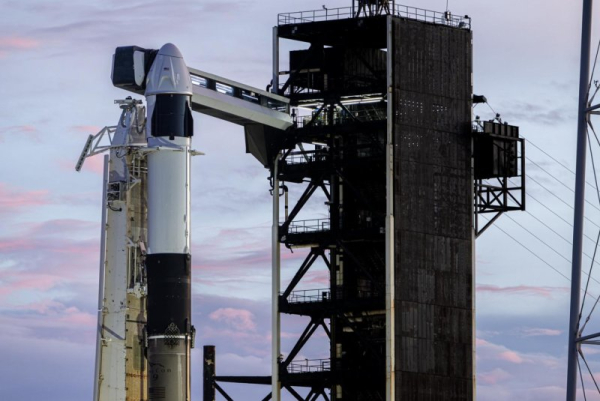SpaceX to attempt early morning Polaris Dawn launch following helium leak delay

1 of 2 | SpaceX’s four-member Polaris Dawn crew is scheduled to launch early Wednesday, as Falcon 9 and Dragon sit on Launch Complex 39A at NASA’s Kennedy Space Center in Florida, after a helium leak scrubbed Tuesday’s launch. The mission will take the crew farther than any human has flown since the end of the Apollo missions. Photo courtesy of Polaris Program/John Kraus
SpaceX will try again early Wednesday to launch the four-person Polaris Dawn crew farther than any human has flown since the end of the Apollo missions after a helium leak postponed Tuesday’s liftoff.
SpaceX is targeting a Wednesday 3:38 a.m. EDT launch of Falcon 9’s Polaris Dawn to low-Earth orbit from NASA’s Kennedy Space Center in Florida. Advertisement
“Falcon 9 and Dragon are vertical on pad 39A ahead of flight. Weather is 85% favorable for liftoff and teams are keeping an eye on recover weather,” SpaceX wrote Tuesday in an update on X.
Falcon 9 and Dragon are vertical on pad 39A ahead of flight. Weather is 85% favorable for liftoff and teams are keeping an eye on recovery weather → https://t.co/WpSw0gzeT0 pic.twitter.com/QXpInu1oFO— SpaceX (@SpaceX) August 27, 2024
Advertisement
If the launch is delayed, there are two additional opportunities to lift-off within a four-hour window at 5:23 a.m. and 7:09 a.m. SpaceX revealed back-up launch times are also available on Thursday.
Tuesday’s launch was scrubbed hours before liftoff after a helium leak was discovered.
“Teams are taking a closer look at a ground-side helium leak on the Quick Disconnect umbilical. Falcon and Dragon remain healthy and the crew continues to be ready for their multi-day mission to low-Earth orbit,” SpaceX wrote Monday night after the launch was postponed.
“An incredible amount of work has gone into this historic mission by an amazing team,” SpaceX founder Elon Musk added. “We are triple-checking everything to make sure there is nothing more we can do to improve crew safety.”
Once launched, the Polaris Dawn crew aboard the SpaceX Dragon capsule will spend five days orbiting Earth and will conduct the first commercial spacewalk in history.
The crew will fly to an initial maximum altitude of about 870 miles before dropping back to a lower cruising orbit. The maximum height is well into the inner band of Earth’s Van Allen radiation belts, which start at around 600 miles in altitude. Advertisement
The all-civilian crew will conduct a spacewalk on the third day to test the function of SpaceX’s new spacesuits, which feature enhanced thermal control materials and technologies. The entire spacewalk from cabin depressurization through repressurization will last approximately two hours.
The Dragon capsule does not have an airlock so the spacewalk will take place closer to Earth, about 435 miles in altitude, where the astronauts will be exposed to the vacuum of space.
On the fourth day, the crew will connect to SpaceX’s Starlink satellite network to transmit a “surprise” message down to Earth, before preparing to return for a splashdown at one of seven sites off the coast of Florida.
The Polaris Dawn crew is led by billionaire philanthropist Jared Isaacman, who is funding the mission in partnership with St. Jude Children’s Research Hospital. Retired U.S. Air Force Lit. Col. Scott “Kidd” Poteet will pilot Polaris. The mission also includes two of the first SpaceX employees to travel to space, Medical Officer Anna Menon and Mission Specialist Sarah Gillis.
“We are grateful to all our friends, family and supporters who have come out to NASA Kennedy for the launch,” Isaacman wrote after Tuesday’s scrub in a post on X. Advertisement
“The best aerospace engineers in the world are working on the issue, and we promise to put on a great show soon enough!”
We are grateful to all our friends, family, and supporters who have come out to @NASAKennedy for the launch. The best aerospace engineers in the world are working on the issue, and we promise to put on a great show soon enough! pic.twitter.com/SV4rAucXRY— Jared Isaacman (@rookisaacman) August 27, 2024
